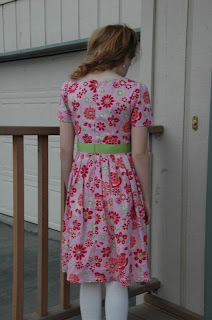My boys have been wanting me to make them something and I have tons of high-tec knits in my stash so I decided to make them some long sleeve t-shirts. Of course I headed straight to my Ottobre mags to find just the right shirt. This was a great t-shirt. It was very easy to sew up and my boys love the fit. I ended up making 3 (the other one is black with grey contrast) and my son who is in the pictures wants more. I think I am done with this shirt for now. Some short sleeve shirts are in order now. Summer is coming and it might be warm enough to wear them. :)
Pattern Sizing: 104-128
Did it look like the photo/drawing on the pattern envelope once you were done sewing with it? Yes, my garments looked like the picture.
Were the instructions easy to follow? I found the instructions were pretty easy to follow. I did have to make sure that I marked the shoulder line. More of the contrast goes to the front than to to back. The first shirt I made I attached the shoulder incorrectly. I put more of the contrast in back. For the other shirts I made sure I marked the shoulder line well.
What did you particularly like or dislike about the pattern? It was a great pattern. It went together pretty well. I didn't understand why they put in a zipper. I didn't put one in my shirts.
Fabric Used: high-tech knit from Rose City TextilesPattern alterations or any design changes you made: I removed the zipper. I also used contrast knit fabric for the shoulder yoke instead of the woven the pattern called for.
Would you sew it again? Would you recommend it to others? DEFINITELY! My youngest son has asked for another one.
Conclusion: Great t-shirt pattern. I like the interesting detail on the shoulders. The shirt sewed up very quickly.
Just thought I would leave you with two more pictures. This shows what Alaskan kids do on the first nice day that comes along after a long winter. It is sunny, 45-50 degrees outside, there is still snow on the ground and my kids are having a water balloon fight. My kids are so anxious for summer. Can't you tell. :)
Thank you for stopping by. Have a great day!
Until next time...













